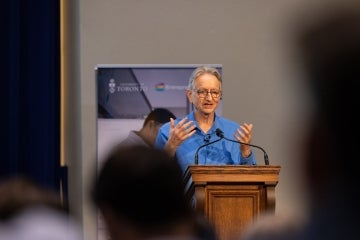U of T and partners to improve flow of goods, traffic with new Smart Freight Centre

Published: April 18, 2019
Leading experts from the University of Toronto, McMaster University and York University are working together to improve –and future-proof – how goods are delivered across the Greater Toronto and Hamilton Area through a newly established Smart Freight Centre.
From delivering stock to stores or packages to individual homes, the demand for freight transportation continues to rise –at the same time that expected delivery windows are narrowing.
The result is more traffic.
“It’s the Amazon effect,” says Matt Roorda, a professor in the department of civil and mineral engineering and the U of T Transportation Research Institute. “People are buying things online and expect them delivered within a day or even within a few hours.
“And that has a real impact on the number of trucks on the road.”
The new centre, officially launched today in Brampton, Ont., will study ways to improve the transportation of goods throughout the region. Among other things, researchers will look at how increased truck traffic contributes to congestion on the roads and competition for parking, both of which pose distribution challenges — especially as populations grow. They will also look at how stop-and-go traffic leads to higher carbon emissions.
As the Smart Freight Centre’s inaugural chair, Roorda says the centre seeks to advance the goals outlined in the Region of Peel’s strategic plan for the movement of goods.
“We want to establish sustainable freight transportation systems that are more efficient and less impactful on communities,” Roorda says.
Roorda’s own project, which launched in February, will see industry partners Walmart, Loblaws and LCBO stores piloting nighttime freight deliveries – shifting key daytime deliveries from distribution centres to retail locations to the late evening, from 7 p.m. to 11 p.m.
“There definitely seems to be a lot of spare capacity on our roadways at different times of day, so why not make better use of our current infrastructure?” says Roorda. “With there being less traffic congestion on the road during that time period, what we hope to see by studying the before and after, is that operations are running faster and more smoothly.”
Roorda’s research group will also look at how the time shift will affect emission levels, examine cost mitigation for companies, and consider whether late-evening noise levels are an issue for residents along freight delivery routes.
Roorda’s pilot is one of three initial projects underway in the new centre, each led by a partner university. York will study the feasibility of establishing truck-only lanes in the region, while McMaster will research e-commerce purchasing behaviours to predict driving trends of future and home-delivery demands.
Roorda and his colleagues at York and McMaster are currently developing the centre’s five-year plan, which will also include research projects on automated trucks and innovative alternatives to last-mile deliveries.
“I think we can make an impact with not just research papers in journals, but with demonstrated projects – there’s one foot in real life happening with this centre,” says Roorda.
“These are on-the-ground problems that we’re trying to solve."



